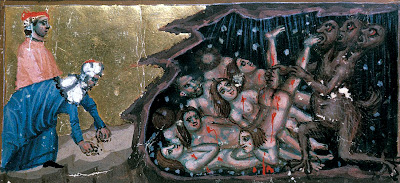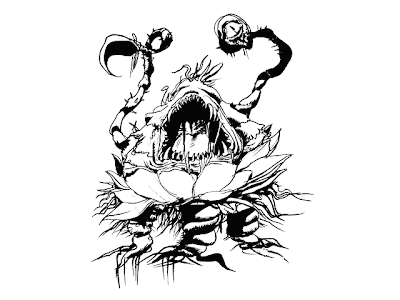
Saturday, May 10, 2008
More Things From Hell

source unknown

Demons Cast Out Of Heaven - Illuminated manuscript from "Apocalypse" dated between 1370-1380.

Miniature Hell scenes, torments of the damned. Attributed to the Master of the Dark Eyes.

Part of a 15th century triptych.

Ecole Flamande - Le Jugement Dernier, 15th c. Full composition on display here.

Bernard Picart - Hell, engraving 1730

Limbourg brothers in "Les Tres Riches Heures - a prayer book of the Duc de Berry" printed in 1416. I thought I'd posted this one awhile back but couldn't find it anywhere on MB. A detailed description of this work can be viewed here.

Cigoli (Lodovico Cardi) Italian, 1559-1613 (designer); Cornelis Galle I, Flemish, 1576-1650 (engraver): Lucifer, from the Divine Comedy, c. 1596 - c. 1605/8, engraving.
I've posted a lot of strange depictions of Lucifer over the past few years but this is one of my favorites. I love that he stands in a giant globe of floating humans from which the three faces are fed, reminds me of Leonord Nemoy's head in that Futurama episode.

source unknown

Demons Cast Out Of Heaven - Illuminated manuscript from "Apocalypse" dated between 1370-1380.

Miniature Hell scenes, torments of the damned. Attributed to the Master of the Dark Eyes.

Part of a 15th century triptych.

Ecole Flamande - Le Jugement Dernier, 15th c. Full composition on display here.

Bernard Picart - Hell, engraving 1730

Limbourg brothers in "Les Tres Riches Heures - a prayer book of the Duc de Berry" printed in 1416. I thought I'd posted this one awhile back but couldn't find it anywhere on MB. A detailed description of this work can be viewed here.

Cigoli (Lodovico Cardi) Italian, 1559-1613 (designer); Cornelis Galle I, Flemish, 1576-1650 (engraver): Lucifer, from the Divine Comedy, c. 1596 - c. 1605/8, engraving.
I've posted a lot of strange depictions of Lucifer over the past few years but this is one of my favorites. I love that he stands in a giant globe of floating humans from which the three faces are fed, reminds me of Leonord Nemoy's head in that Futurama episode.
Friday, May 09, 2008
Gustave Henri Jossot 
Drawing of the devil, 1903.
Image found in this collection of Jossot artworks.

Formaldehyde Drinker in L'Assiette au Beurre 1907 - "A frightening caricature by the anarchist artist Jossot, showing a deranged mortician drinking formaldehyde used to preserve a dead foetus."

There are a handful of color lithographs by Jossot depicting living skeletons here.
To see more work by Jossot browse through copies of L'Assiette au Beurre.
Read more on Jossot at Wikipedia..

Drawing of the devil, 1903.
Image found in this collection of Jossot artworks.

Formaldehyde Drinker in L'Assiette au Beurre 1907 - "A frightening caricature by the anarchist artist Jossot, showing a deranged mortician drinking formaldehyde used to preserve a dead foetus."

There are a handful of color lithographs by Jossot depicting living skeletons here.
To see more work by Jossot browse through copies of L'Assiette au Beurre.
Read more on Jossot at Wikipedia..
Yongbo Zhao

Revolutionäre Familie - Portraits I: (2001)

Revolutionäre Familie - Portraits II, Bruder, 1996,
 Revolutionäre Familie - Portraits I: Vater (1997)
Revolutionäre Familie - Portraits I: Vater (1997)
More paintings from Zhao can be viewed at the Galerie KK and here.

Revolutionäre Familie - Portraits I: (2001)

Revolutionäre Familie - Portraits II, Bruder, 1996,
 Revolutionäre Familie - Portraits I: Vater (1997)
Revolutionäre Familie - Portraits I: Vater (1997)More paintings from Zhao can be viewed at the Galerie KK and here.
Thursday, May 08, 2008
Master of the Antiphonar of Padua - Dante's Divine Comedy Miniatures, 14th c

These miniature paintings illustrating Dante's Divine Comedy aren't the best I've ever seen but there are a few stand out works such as the above depiction of a bizarre
Cerberus grasping a soul.


These miniature paintings illustrating Dante's Divine Comedy aren't the best I've ever seen but there are a few stand out works such as the above depiction of a bizarre
Cerberus grasping a soul.

Vaticinia de Pontificibus
 "Miniature of a human-headed dragon, representing the papacy of Urban VI whose election was contested and resulted in the appointment of the anti-pope Clement VII."
"Miniature of a human-headed dragon, representing the papacy of Urban VI whose election was contested and resulted in the appointment of the anti-pope Clement VII."

Miniature of Pope John XXII.

Miniature of Pope Benedict XI.
"A series of manuscript prophecies concerning the Papacy, under the title of Vaticinia de Summis Pontificibus, a Latin text which assembles portraits of popes and prophecies related to them, circulated from the late thirteenth-early fourteenth century, with prophecies concerning popes from Pope Nicholas III onwards.
The mystical series of prophecies, known from their incipit as the Genus nequam prophecies, are derived from the Byzantine Leo Oracles, a series of twelfth-century Byzantine prophecies that foretell a savior-emperor destined to restore unity to the empire. Their poems and tempera illuminations mix fantasy, the occult, and chronicle in a chronology of the popes. Each prophecy consists of four elements, an enigmatic allegorical text, an emblematic picture, a motto, and an attribution to a pope."
- quote source from Wikipedia.
A detailed description along with dozens more miniature paintings from this illuminated manuscript can be found in this gallery at the British Library website.
 "Miniature of a human-headed dragon, representing the papacy of Urban VI whose election was contested and resulted in the appointment of the anti-pope Clement VII."
"Miniature of a human-headed dragon, representing the papacy of Urban VI whose election was contested and resulted in the appointment of the anti-pope Clement VII."
Miniature of Pope John XXII.

Miniature of Pope Benedict XI.
"A series of manuscript prophecies concerning the Papacy, under the title of Vaticinia de Summis Pontificibus, a Latin text which assembles portraits of popes and prophecies related to them, circulated from the late thirteenth-early fourteenth century, with prophecies concerning popes from Pope Nicholas III onwards.
The mystical series of prophecies, known from their incipit as the Genus nequam prophecies, are derived from the Byzantine Leo Oracles, a series of twelfth-century Byzantine prophecies that foretell a savior-emperor destined to restore unity to the empire. Their poems and tempera illuminations mix fantasy, the occult, and chronicle in a chronology of the popes. Each prophecy consists of four elements, an enigmatic allegorical text, an emblematic picture, a motto, and an attribution to a pope."
- quote source from Wikipedia.
A detailed description along with dozens more miniature paintings from this illuminated manuscript can be found in this gallery at the British Library website.
Wednesday, May 07, 2008
Temptations Of Saint Anthony


Painted glass windows

George Cruikshank - Saint Anthony, etching and aquatint, 18th - 19th century

Jan Wellens de Cock - Landscape With The Temptation Of Saint Anthony

The temptation of St Antony. Lithograph silhouettes. artist unknown


Saint Antony. Engraving by P. Picault after J. Callot.

Temptation of Saint Antony. Etching by J.P. Le Bas after D. Teniers.

Temptation of Saint Antony. Etching by L. Figlio after D. Teniers.

Temptation of Saint Antony. Line engraving by L. Sullivan after D. Teniers.

Temptation of Saint Antony. Engraving.

The temptation of St Antony. Pastel drawing by W.S.

Temptation of Saint Antony. Engraving by C. Lambertini after S. Rosa.


Painted glass windows

George Cruikshank - Saint Anthony, etching and aquatint, 18th - 19th century

Jan Wellens de Cock - Landscape With The Temptation Of Saint Anthony

The temptation of St Antony. Lithograph silhouettes. artist unknown


Saint Antony. Engraving by P. Picault after J. Callot.

Temptation of Saint Antony. Etching by J.P. Le Bas after D. Teniers.

Temptation of Saint Antony. Etching by L. Figlio after D. Teniers.

Temptation of Saint Antony. Line engraving by L. Sullivan after D. Teniers.

Temptation of Saint Antony. Engraving.

The temptation of St Antony. Pastel drawing by W.S.

Temptation of Saint Antony. Engraving by C. Lambertini after S. Rosa.
Tuesday, May 06, 2008
Sunday, May 04, 2008
Sanctuario de Atotonilco

"A pilgrimage site to a small church known for its paintings by Miguel Antonio de Pocosangre (or so I have been told). Located near San Miguel de Allende and Delores Hidalgo in the state of Guanajuato.
Antonio de Pocosangre was a Mexican who learned his skills in 16th century European painting techniques without formal training."
- quote and images found on this flickr page.
The two week block of monsters in movie posters and pulp magazine covers begins next Sunday.





"A pilgrimage site to a small church known for its paintings by Miguel Antonio de Pocosangre (or so I have been told). Located near San Miguel de Allende and Delores Hidalgo in the state of Guanajuato.
Antonio de Pocosangre was a Mexican who learned his skills in 16th century European painting techniques without formal training."
- quote and images found on this flickr page.
The two week block of monsters in movie posters and pulp magazine covers begins next Sunday.




Subscribe to:
Comments (Atom)
















